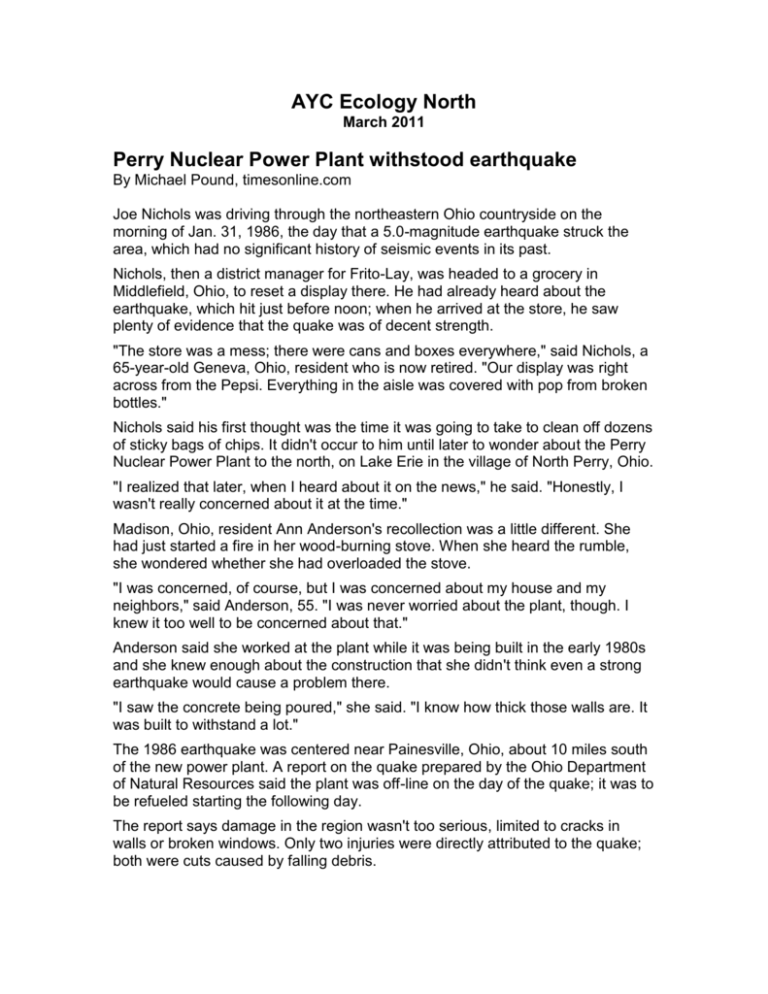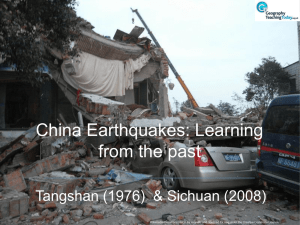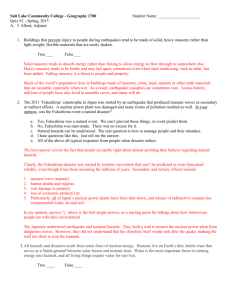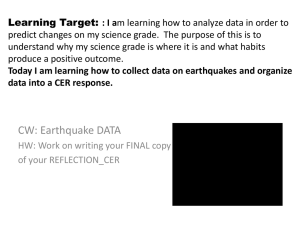Perry Nuclear Power Plant withstood earthquake
advertisement

AYC Ecology North March 2011 Perry Nuclear Power Plant withstood earthquake By Michael Pound, timesonline.com Joe Nichols was driving through the northeastern Ohio countryside on the morning of Jan. 31, 1986, the day that a 5.0-magnitude earthquake struck the area, which had no significant history of seismic events in its past. Nichols, then a district manager for Frito-Lay, was headed to a grocery in Middlefield, Ohio, to reset a display there. He had already heard about the earthquake, which hit just before noon; when he arrived at the store, he saw plenty of evidence that the quake was of decent strength. "The store was a mess; there were cans and boxes everywhere," said Nichols, a 65-year-old Geneva, Ohio, resident who is now retired. "Our display was right across from the Pepsi. Everything in the aisle was covered with pop from broken bottles." Nichols said his first thought was the time it was going to take to clean off dozens of sticky bags of chips. It didn't occur to him until later to wonder about the Perry Nuclear Power Plant to the north, on Lake Erie in the village of North Perry, Ohio. "I realized that later, when I heard about it on the news," he said. "Honestly, I wasn't really concerned about it at the time." Madison, Ohio, resident Ann Anderson's recollection was a little different. She had just started a fire in her wood-burning stove. When she heard the rumble, she wondered whether she had overloaded the stove. "I was concerned, of course, but I was concerned about my house and my neighbors," said Anderson, 55. "I was never worried about the plant, though. I knew it too well to be concerned about that." Anderson said she worked at the plant while it was being built in the early 1980s and she knew enough about the construction that she didn't think even a strong earthquake would cause a problem there. "I saw the concrete being poured," she said. "I know how thick those walls are. It was built to withstand a lot." The 1986 earthquake was centered near Painesville, Ohio, about 10 miles south of the new power plant. A report on the quake prepared by the Ohio Department of Natural Resources said the plant was off-line on the day of the quake; it was to be refueled starting the following day. The report says damage in the region wasn't too serious, limited to cracks in walls or broken windows. Only two injuries were directly attributed to the quake; both were cuts caused by falling debris. And as was the case everywhere else, the plant seemed to hold up well. It was shut down for a time while inspectors checked the structure. They located only minor cracks in concrete and small leaks in "non-critical pipes." FirstEnergy has said Perry was constructed to withstand a magnitude-6 earthquake, a slightly higher rating than Beaver Valley in Shippingport, which was built to survive a 5.8 quake. A citizens group, which had opposed the Perry plant's construction, sued after the quake, saying a subsequent quake that could exceed what the plant was built to withstand was likely. That suit was eventually turned down by the U.S. Supreme Court. After the initial quake, a team of geologists recorded at least 13 aftershocks over the next two months, the strongest of which was a 2.4 magnitude. None of the aftershocks caused any significant damage. "I know they paid a lot of attention to that plant after the earthquake, which is one of the reasons I don't worry about it a whole lot now," said Madison resident Skip Oravetz, 58. "It's been through one, and it was fine. What are the chances we're going to get one bigger than that?" THE BIG QUESTION The question posed by Oravetz is the central query anytime construction begins on a new power plant in the United States, according to the U.S. Nuclear Regulatory Commission. As the design process begins, geologists look at historical seismic data for the region - including the strength of past quakes and possible acceleration, or the speed of waves generated by the quake during those events - and calculate what they think is a worst-case scenario for that area. That's a standard practice for any construction that considers seismic activity, said Helen Delano, a senior geologic scientist with the Pennsylvania Bureau of Topographic and Geologic Survey, and while it's fairly accurate, it can be difficult to be specific. "If we're talking about an area with a history of seismic activity, there's a good chance that those estimates are going to be better because we know more about activity there," Delano said. "It becomes a little harder in an area where there has been little recorded seismic activity." That's the case in western Pennsylvania, Delano said. There are no recorded earthquakes in Beaver, Lawrence or Allegheny counties, so there's no history on which to base estimates. There have been some farther north. Erie and Crawford counties both have had earthquakes, and the 5.1-magnitude quake on Sept. 25, 1998, probably the biggest in the state's history, was centered in northern Mercer County. A lack of past activity also means it's likely that there aren't many seismic monitors nearby. That was the case for this region until fairly recently, Delano said, when several new ones, including ones in Allegheny and Butler counties, were placed around the state as part of a national push to gather more data on quakes around the world. "That project has an international focus, but we stand to learn a lot more about areas we haven't paid a lot of attention to," Delano said. "I don't know if we'll find out anything that would cause those estimates to change, but I suspect we'll find out about some smaller earthquakes we didn't know were occurring." The Perry quake occurred in an area with a seismic past, but it was far stronger than any quakes that had hit that region previously. Could something similar happen here? Delano said it's not likely, but she couldn't rule it out. "We look at the history, and we have to think that something in the range of a magnitude 5 earthquake probably isn't going to happen in the Pittsburgh area," she said. "Can I say that with certainty? No." ‘IT DOESN'T BOTHER ME' The Perry plant sits on the shore of Lake Erie. Just one of its two reactors is active, and on a cool, clear day, the steam from the cooling tower seems to billow for miles, a constant reminder of its presence. Ashtabula resident Virginia March works in Perry, Ohio, a couple of miles south of the nuclear plant, as director of the town's public library. She said she spent a little more time thinking about her proximity to the plant since the disaster in Japan, but it hasn't been a source of concern for her, or for the community. "You think about it, sure. I know I checked to make sure I knew were my iodide pills are this week," March said. "But the power plant has been a good neighbor over the years. There haven't been any problems. The community has benefited financially because it's there. I think we're at the point where we appreciate that it's a part of the community." It's been years since Anderson worked at the plant. She now pours coffee at a small shop in Madison, but she still has a connection with her former employer; it's where her husband continues to work. "I think the people who get upset about nuclear energy are those who don't live nearby a plant like ours," she said. "For the people here, it's a fact of life, and it's not something that we worry about, even after what happened in Japan. "I know it doesn't bother me," she said. "If it did, I wouldn't send my husband to work there every day."











